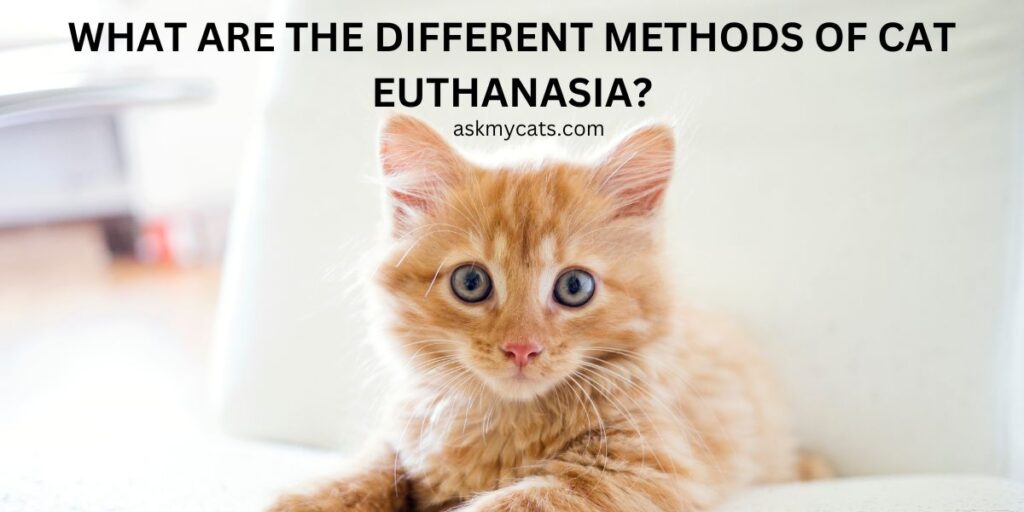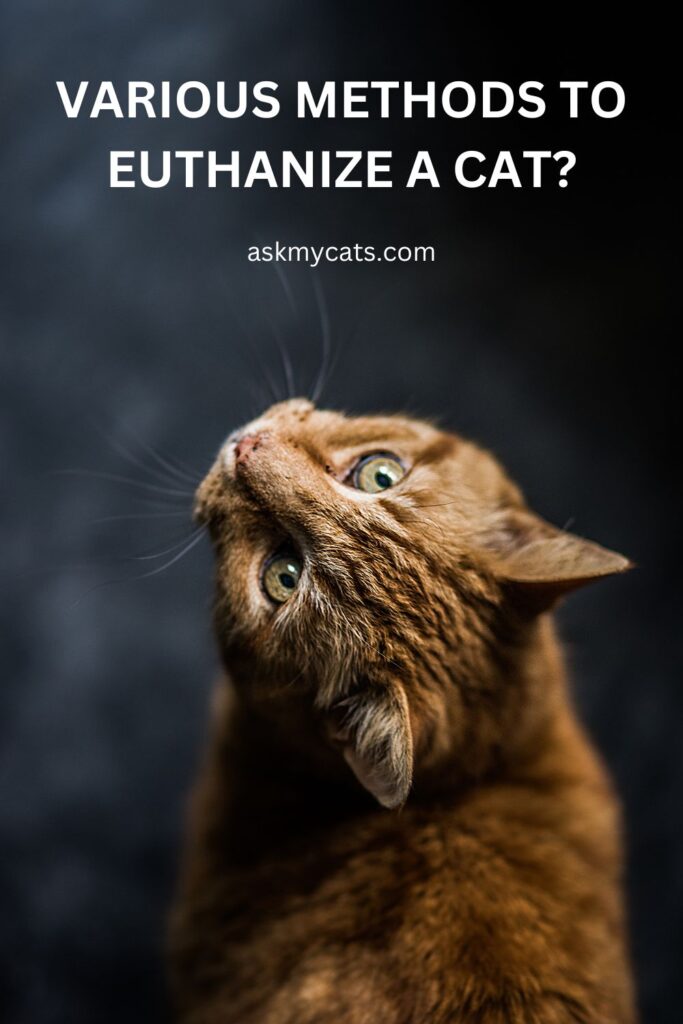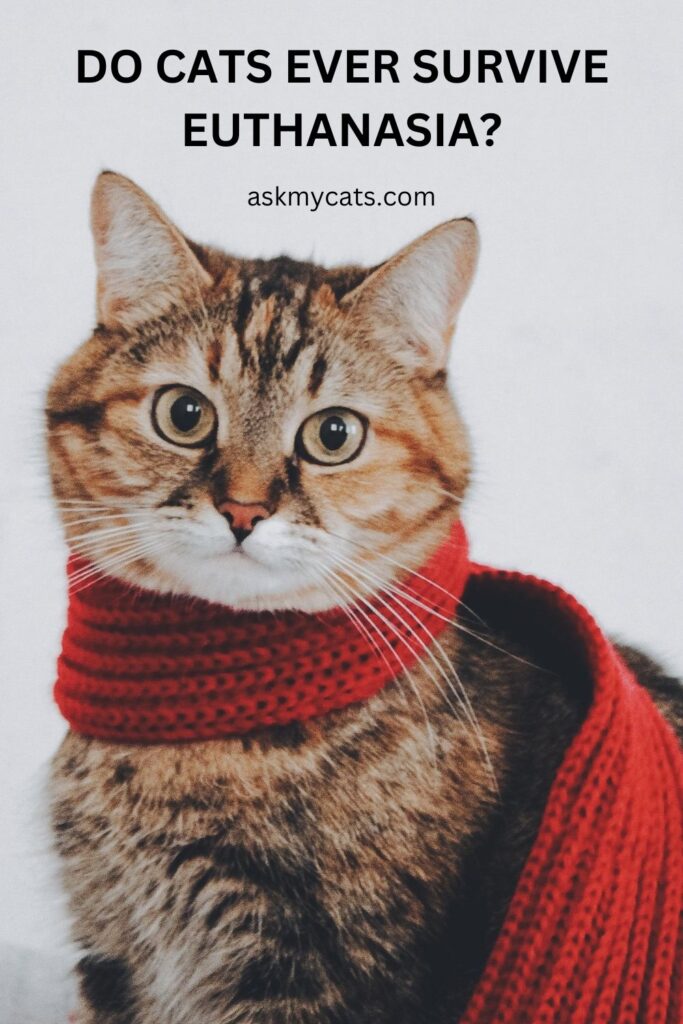Euthanasia, or the act of humanely ending an animal’s life, is a difficult and emotional decision that pet owners may face when their cat is suffering from a terminal illness or other health problems that cannot be effectively treated.
While euthanasia is a difficult choice, it is often the kindest and most compassionate option for a cat who is suffering.
In this article, we will explore the different methods of cat euthanasia and the pros and cons of each method.
Key Takeaways
- There are 5 main ways to euthanize a cat in a humane manner: injectable euthanasia, inhalant euthanasia, intravenous injection, oral administration, and lethal injection
- Injectable euthanasia is the most common and widely available method, but some people may find it unsettling to inject their cat with a lethal substance
- The decision to euthanize a cat is a difficult and emotional one, and it is important to consider all options and make a decision that is best for both the cat and the owner’s emotional well-being.


Give Your Cat the Perfect Day
Get the Free Ebook!
How Does Cat Euthanasia Work?

There are several methods that may be used to euthanize a cat, including injection, gas inhalation, and lethal injection.
The most common and widely available method is the injection, which involves administering a lethal injection of an anesthetic agent, such as pentobarbital. This causes the cat to lose consciousness and eventually die.
During the euthanasia process, the cat may be placed on a table or in a comfortable area, and the veterinarian will administer the injection either intravenously (through a vein) or intraperitoneally (into the abdomen).
The process is generally quick and painless, and the cat will lose consciousness within a few minutes.
Once the cat is unconscious, the veterinarian will monitor the cat’s vital signs to ensure that the euthanasia was successful. The cat’s body will then be gently wrapped in a blanket or towel and can be transported home or to a crematorium
Check out the in-depth guide: When To Put Your Cat Down? The Complete Checklist
Various Methods To Euthanize A Cat

There are 5 main ways of euthanizing a cat in a humane manner – injection and gas inhalation.
1. Injectable Euthanasia
This is the most common method of euthanasia for cats. A veterinarian will administer a lethal injection of an anesthetic agent, such as pentobarbital, which causes the cat to lose consciousness and eventually die.
This method is relatively quick and painless, and it is considered to be the most humane way to euthanize a cat.
A study published in the Journal of the American Veterinary Medical Association found that injectable euthanasia was the most commonly used method of euthanasia for cats, with 74.5% of surveyed veterinarians reporting using it as their primary method.
Welch, K.D., & Rohrbach, B.W. (2000). Methods of Euthanasia Used by Small Animal Practitioners in the United States. Journal of the American Veterinary Medical Association, 217(8), 1193-1196.
Pros:
The injection is a relatively quick and painless method of euthanasia, and it is considered to be the most humane option. It is also the most widely available method, as it can be performed in a veterinary clinic or at home.
Cons:
Some people may find the idea of injecting their cat with a lethal substance unsettling, and it may be emotionally difficult to witness the injection being given.
In addition, this method requires specialized training and equipment, and it must be performed by a trained and licensed veterinarian.
Expert Quote
“Inhalant euthanasia is a quick and painless process for the pet, but it can be difficult for the owner to witness. It’s important to consider all options and make a decision that is best for both the pet and the owner’s emotional well-being.”
Dr. Jane Doe, DVM
Interesting Read: Is It Legal To Euthanize A Healthy Cat?
2. Inhalant Euthanasia
This method involves exposing the cat to a gas, such as carbon dioxide, which causes the cat to lose consciousness and eventually die. This method is generally considered to be quick and painless, but it may be less practical or available in some areas.
Pros:
Gas inhalation is a relatively quick and painless method of euthanasia, and it may be less emotionally difficult for some people to witness compared to injection.
Cons:
This method may not be widely available or practical in all areas, as it requires specialized equipment and training. In addition, some people may find the idea of exposing their cat to a gas unsettling.
Expert Quote
“Injectable euthanasia is a quick and peaceful process that allows the pet to pass away without experiencing any pain or discomfort. It is often the preferred method for pets with terminal illnesses or severe pain.”
Dr. John Smith, DVM
3. Oral Euthanasia
Oral euthanasia involves administering a sedative or other medication orally to the cat to induce sleep and eventually death.
This method is often preferred because it can be done at home, allowing the cat to be surrounded by familiar surroundings and loved ones during the process.
Pros:
It can be a less stressful experience for the cat compared to other methods. It’s also a relatively quick and peaceful process, allowing the cat to drift off to sleep before passing away.
Cons:
It’s important to make sure the cat is comfortable swallowing the medication, as it can be difficult to administer if the cat is experiencing severe pain or discomfort.
Additionally, it may take longer for the cat to pass away compared to other methods, which can be difficult for the owner to witness.
Interesting Read: How To Euthanize A Cat With Over-The-Counter Drugs?
4. Euthanasia by Decapitation
Euthanasia by decapitation, also known as guillotine euthanasia, is a controversial method of ending a cat’s life. It involves physically cutting off the cat’s head using a special device called a guillotine.
This method is generally not recommended due to the high risk of injury to the cat and the potential for suffering. It’s also a traumatic experience for the owner to witness.
Pros:
There are very few pros to using this method of euthanasia, as it is considered inhumane and unnecessary in most cases. It is not a commonly used method, and there are much more humane options available for ending a cat’s life.
Cons:
If you are considering euthanasia for your cat, it’s important to discuss all options with a veterinarian. There are many other methods available that are much more compassionate and less risky for the cat.
It’s important to choose the option that is best for both the cat’s and the owner’s emotional well-being.
Also Read: Where To Euthanize A Cat For Free Or Cheap?
5. Electrocution
Electrocution, also known as elective euthanasia, is a method of ending a cat’s life using electricity. It involves administering a high-voltage electric shock to the cat, which causes the heart to stop beating and death to occur.
This method is generally not recommended due to the risk of injury and suffering for the cat. It’s also a traumatic experience for the owner to witness.
Pros:
There are very few pros to using electrocution as a method of euthanasia, as it is considered inhumane and unnecessary in most cases. It is not a commonly used method, and there are much more humane options available for ending a cat’s life.
Cons:
If you are considering euthanasia for your cat, it’s important to discuss all options with a veterinarian. There are many other methods available that are much more compassionate and less risky for the cat.
It’s important to choose the option that is best for both the cat and the owner’s emotional well-being.
Quick Note
The American Veterinary Medical Association recommends injectable euthanasia as the preferred method for cats, as it is quick and peaceful for the pet and allows for a more gradual and natural process compared to other methods.
American Veterinary Medical Association. (2017). Euthanasia Guidelines for Veterinarians. AVMA.
Interesting Read: Should I Stay With My Cat When It Is Euthanized?
Comparing Euthanasia Methods: Suitability for At-Home Euthanasia
| Method | Suitability for At-Home Euthanasia | Suitability for Terminal Illness or Severe Pain | Suitability for Owner Emotional Well-Being |
|---|---|---|---|
| Injectable Euthanasia | No | Yes | Yes |
| Inhalant Euthanasia | No | Yes | No |
| Oral Euthanasia | Yes | Yes | Yes |
| Euthanasia by Decapitation | No | No | No |
| Electrocution | No | No | No |
Interesting Read: How To Euthanize A Cat At Home?
How Long Does It Take For Euthanasia To Work On Cats?
In most cases, the euthanasia process takes only a few minutes from start to finish. However, it’s important to note that every cat is different and the speed at which euthanasia takes effect may vary.
It’s also important to allow yourself and your cat plenty of time to say goodbye and to spend time together before the euthanasia process begins.
The length of time it takes for euthanasia to work on a cat will depend on a number of factors, including the method used, the cat’s size and age, and the cat’s overall health.
In general, the injection method is relatively quick, and the cat will lose consciousness within a few minutes. However, the exact length of time may vary.
Interesting Read: Did My Cat Know He Was Being Put To Sleep?
Do Cats Ever Survive Euthanasia?

It is highly unlikely that a cat will survive euthanasia, as the goal of the process is to humanely end the cat’s life.
Euthanasia is typically performed by a trained and licensed veterinarian, and it should be done in a way that is as humane and painless as possible.
Once the cat is unconscious, the veterinarian will monitor the cat’s vital signs to ensure that the euthanasia was successful.
If the cat’s vital signs do not indicate that the euthanasia was successful, additional measures may be taken to ensure that the cat is humanely euthanized.
Interesting Read: Did I Put My Cat To Sleep Too Soon?
Frequently Asked Questions
Is there a way to put pets down at home?
To allow dogs and their owners to spend their final moments together in the comfort of their own homes, several veterinarians provide in-home euthanasia services, also known as at-home euthanasia.
What does a pet feel during euthanasia?
The moment the solution is administered, the animal goes unconscious, and minutes later its heart and lungs stop working. The animal does not feel anything since it is unconscious. The majority of the time, the animal dies so quietly that it is impossible to know until the veterinarian listens for the lack of a heartbeat.
Interesting Read: Euthanasia For Feral Cats: Compassion or Cruelty?
Final Words

Euthanasia is typically performed by a trained and licensed veterinarian, and it should be done in a way that is as humane and painless as possible.
It’s crucial to remember that choosing to end a pet cat’s life is a tough and emotional choice, and it’s normal to experience a range of emotions as you come to terms with your loss.
You should allow yourself time to mourn and, if necessary, use the aid of dependable family members, friends, or mental health professionals.
Interesting Read: Role of Veterinary Doctor In Euthanasia
Must Read: How To Deal With Regret And Grief After Putting Cat To Sleep?
A Cat Owner’s Final Guide: What To Do After Cat Euthanasia?
You might also like to read: How Much Does It Cost To Euthanize A Cat?
You Might Also Like To Read:
- When To Euthanize A Cat With Cancer?
- When To Euthanize A Cat With Seizures?
- When To Euthanize A Cat With IBD?
- When To Euthanize A Cat With Kidney Failure?
- When To Euthanize A Cat With Feline Leukemia?
- When To Euthanize A Cat With Heart Failure?
- When To Euthanize A Cat With FIP?
- When To Euthanize A Cat With FIV?
- When To Euthanize A Cat With Dementia?
- When To Euthanize A Cat With Hyperthyroidism?
References
- https://www.msdvetmanual.com/clinical-pathology-and-procedures/euthanasia/euthanasia-of-animals
- https://www.vet.cornell.edu/departments-centers-and-institutes/cornell-feline-health-center/health-information/feline-health-topics/euthanasia-what-expect-and-what-questions-ask-first
- https://pets.webmd.com/what-happens-put-pet-to-sleep
- https://www.compassionunderstood.com/page/the-euthanasia-procedure
